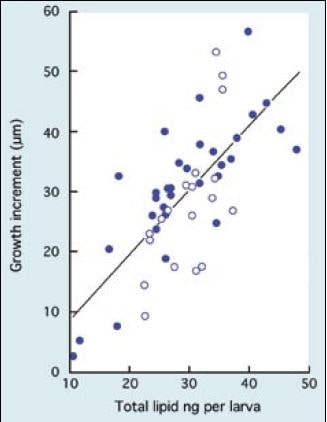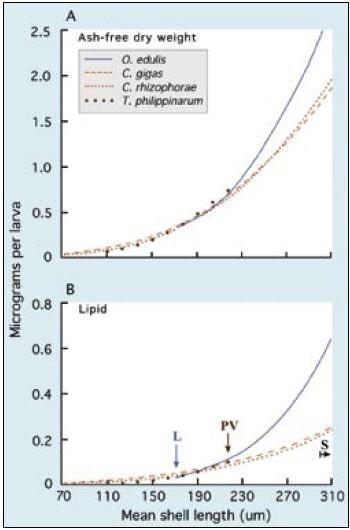5.3.4 Egg and larval quality
The quality of eggs in terms of their quantitative and qualitative biochemical composition also has a bearing on subsequent performance of larvae. Studies on this topic have mainly focussed on lipid content and, in particular, on the importance and role of highly unsaturated fatty acids (HUFAs) either donated by the female during oogenesis or mobilised directly from the diet during the period of egg maturation prior to spawning.
142-1
Figure 77: The highly unsat urated fatty acid composi tion of Manila clam, Tapes philippinarum, eggs from a hatchery-held broodstock provided with different diets during conditioning.
Control clams were kept in unfiltered seawater while others were supplied a 3% ration of either Dunaliella tertiolecta, Tetraselmis suecica or Thalassiosira pseudonana in 2?m fil tered seawater. (I. Laing, A. R Child and M. M. Helm – previously unpublished data).
The conditions to which females are exposed during oogenesis and egg maturation can have a profound effect both on fecundity and the quality of eggs subsequently spawned. Diet composition and abundance of food are of great importance and apply equally to stocks in their natural habit and in the hatchery broodstock conditioning environment. The HUFA composition of freshly spawned eggs can be significantly altered by the diet provided during conditioning (Figure 77) but there is no evidence that such changes exert a readily discernable effect on the viability and vigour of the larvae developing from the eggs. Neither is there any evidence to suggest that larvae from wild stock European flat oysters are any more or less viable than from a hatchery conditioned stocks although their HUFA profiles may be very different (Figure 78). The differences may be too subtle to be obvious in the context of hatchery culture where efforts are made to provide near optimal conditions for the larvae.

Figure 78: A comparison of the highly unsaturated fatty acid composition of hatchery conditioned and wild stock European flat oyster, Ostrea edulis, larvae. Fatty acids are differentiated into neutral (tri acylglycerols) and polar (struc tural) components. Modified from M.M. Helm et al. (1991).
What tends to be more important is the total lipid content of newly spawned eggs, or of newly liberated larvae in the case of the European flat oyster. Total lipid as a proportion of the ash-free dry (organic) weight of Pacific oyster eggs is positively correlated with the percentage that develop to the D-larva stage (Figure 79). Even when using a standard broodstock conditioning protocol, lipid content can vary widely according to time of the year and from year to year (Figure 80A). This may be explained by the quantity, diversity and nutritional value of food present in unfiltered seawater supplied to conditioning tanks before cultured algae is added (Figure 80B). It may also help to explain why some years in the hatchery are more productive and suffer fewer disruptions than others.

Figure 79: Relationship between total lipid as a percentage of dry weight and the percentage of Pacific oyster, Crassostrea gigas, eggs that develop to the D-larva stage. From S.D. Utting and M.M. Helm (1985) and previously unpublished data.
In larviparous oysters, e.g. Ostrea edulis, the growth increment of larvae in the 4-day period following liberation from adults is significantly correlated with lipid content at the time of release, suggesting the importance of maternally donated reserves during early larval development (Figure 81). Again there are indications of seasonality and differences between years. However, such effects become less pronounced as larvae continue to develop when diet and ration fed day by day are of overriding influence.
There is close similarity in the relationship between shell length and the ash-free dry weight of larvae amongst most of the bivalve species commonly cultured when they are each grown in near optimum conditions (Figure 82A). The exception among species investigated is the larviparous oyster, Ostrea edulis, where there is increasing divergence in shell length related ash-free dry weight in later stage larvae compared with larvae of Crassostrea sp. This is explained by the more than 3-fold difference in the rate at which lipid is accumulated as larvae grow towards metamorphosis (Figure 82B). Studies suggest that lipid is much more important as an energy source during metamorphosis in Ostrea edulis than it is in the oviparous oysters.

Figure 80: Relationships between the total lipid content of freshly spawned Pacific oyster eggs (expressed as lipid per million eggs) and, (A) months of the year in two different years and (B), the chlorophyll – ? content of unfiltered seawater supplied to broodstock in a hatchery when employing a standard conditioning protocol. From Utting and Helm (1985) and previously unpublished data.

Figure 81: The relationship between the growth increment of Ostrea edulis larvae in a 4-day period from liberation and total lipid content at liberation from hatchery conditioned broodstocks. Each data point represents a specific brood of larvae over a 2-year period – each year differentiated according to the shading of the data point. Larvae were cultured on the beaker scale in artificial seawater and provided with the same diet and ration to provide standardized conditions throughout the sequence of trials. From M.M. Helm (1971) and previously unpublished data.

Figure 82: A comparison of increases in both (A) ash free dry (organic) weight and (B) lipid content per larva relative to mean shell length in larvae of four bivalve species.
L – denotes mean size at liberation of Ostrea edulis larvae; PV – the onset of the pediveliger stage in Tapes philippinarum and S – the onset of settlement in the three oysters. Source: M.M. Helm – previously unpublished data.